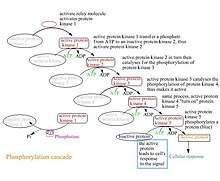Phosphorylation cascade
A phosphorylation cascade is a sequence of signaling pathway events where one enzyme phosphorylates another, causing a chain reaction leading to the phosphorylation of thousands of proteins. This can be seen in signal transduction of hormone messages.

A signaling pathway begins at the cell surface where a hormone or protein binds to a receptor at the Extracellular matrix. The interactions between the molecule and receptor causes a Conformational change at the receptor, which activates multiple enzymes or proteins. These enzymes activates secondary messengers that leads to the phosphorylation of thousands of proteins. The end product of Phosphorylation cascade is the changes occurring inside the cell.
One best example that explains this phenomena is mitogen-activated protein (MAP) kinase or ERK kinase[1]. MAP kinase not only plays an important function during growth of cell in the M phase phosphorylation cascade but also plays an important role during the sequence of signaling pathway[2]. In order to regulate its functions so it does not cause chaos, it can only be active when both tyrosine and threonine/serine residues are phosphorylated[3].
References
- Denhardt, David T. (1996-09-15). "Signal-transducing protein phosphorylation cascades mediated by Ras/Rho proteins in the mammalian cell: the potential for multiplex signalling". Biochemical Journal. 318 (3): 729–747. doi:10.1042/bj3180729. ISSN 0264-6021. PMC 1217680. PMID 8836113.
- Man, The Protein. "Protein Kinases and Phosphatases: drivers of phosphorylation and dephosphorylation". info.gbiosciences.com. Retrieved 2020-04-28.
- Matsuda, S.; Kosako, H.; Takenaka, K.; Moriyama, K.; Sakai, H.; Akiyama, T.; Gotoh, Y.; Nishida, E. (1 March 1992). "Xenopus MAP kinase activator: identification and function as a key intermediate in the phosphorylation cascade". The EMBO Journal. 11 (3): 973–982. doi:10.1002/j.1460-2075.1992.tb05136.x. ISSN 0261-4189. PMC 556538. PMID 1312468.
- Freeman, Scott; et al. (2005). "Index I" Biological Science Vol. 2. Pearson Education, Inc.